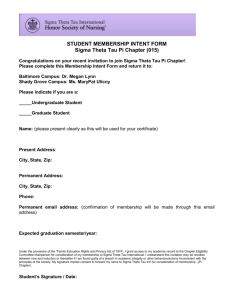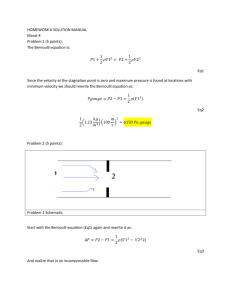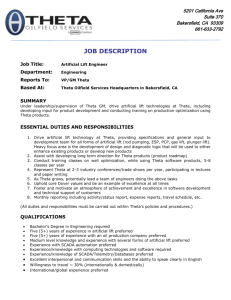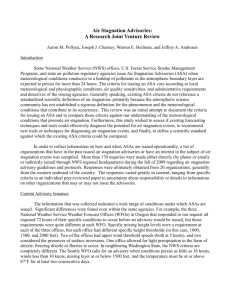Help Session 5 Notes
advertisement
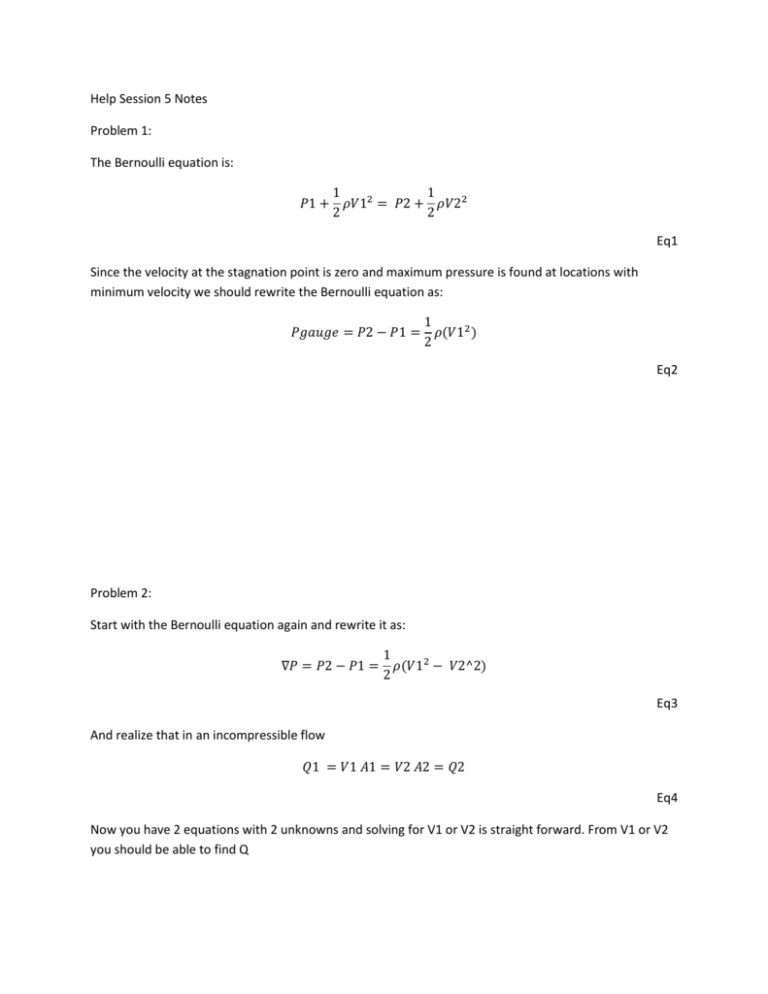
Help Session 5 Notes
Problem 1:
The Bernoulli equation is:
1
1
𝑃1 + 𝜌𝑉12 = 𝑃2 + 𝜌𝑉22
2
2
Eq1
Since the velocity at the stagnation point is zero and maximum pressure is found at locations with
minimum velocity we should rewrite the Bernoulli equation as:
1
𝑃𝑔𝑎𝑢𝑔𝑒 = 𝑃2 − 𝑃1 = 𝜌(𝑉12 )
2
Eq2
Problem 2:
Start with the Bernoulli equation again and rewrite it as:
1
∇𝑃 = 𝑃2 − 𝑃1 = 𝜌(𝑉12 − 𝑉2^2)
2
Eq3
And realize that in an incompressible flow
𝑄1 = 𝑉1 𝐴1 = 𝑉2 𝐴2 = 𝑄2
Eq4
Now you have 2 equations with 2 unknowns and solving for V1 or V2 is straight forward. From V1 or V2
you should be able to find Q
Problem 3:
Please read pages 227 to 237 in the textbook since it discusses this problem in detail. Also refer to Figure
3.22 for a diagram for this problem. You can solve this using potential flow or stream function but I will
use the latter in this derivation. First derive the stream function for the entire flow by adding the stream
function for uniform flow and a source. If do that correctly you should end up with Eqn 3.75
𝜓 = 𝑉∞ 𝑦 +
𝑄
𝜗
2𝜋
Eq5
𝜓 = 𝑉∞ 𝑟 𝑠𝑖𝑛𝜗 +
𝑄
𝜗
2𝜋
Eq6
This equation defines the stream function for the entire flow but we are only interested in the flow over
the body, which contains the stagnation point. Therefore you should compute velocities from the
stream function as:
𝑉𝑟 =
1 𝑑𝜓
𝑄
= 𝑉∞ cos 𝜎 +
𝑟 𝑑𝜗
2𝜋𝑟
Eq7
𝑉𝜗 = −
𝑑𝜓
= − 𝑉∞ sin 𝜎
𝑑𝑟
Eq8
By setting the two equations above to zero you will be able to solve for r and θ at the stagnation point
and part c of this problem. (Hint: look at the bottom of page 234)
If you plug r and θ into Eqn 3.75 you will find the stream function that contains the stagnation point. If
done correctly you should end up with:
𝜓=
𝑄
2
Eq9
To find the rest of points on the body simply solve for r along the computed streamline. This is
demonstrated bellow.
𝜓 = 𝑉∞ 𝑟 𝑠𝑖𝑛𝜎 +
𝑄
𝑄
𝜗=
2𝜋
2
Eq10
Let’s rewrite the above equations in terms or x and y that will be easier to plot.
𝜓 = 𝑉∞ 𝑦 +
𝑦=
𝑄
𝑦
𝑄
arctan ( ) =
2𝜋
𝑥
2
𝑄
1
𝑦
( 1 − arctan ( ))
2𝑉∞
π
𝑥
Eq11
Now to find the height of the body above the centerline take a limit of the previous equation at x ∞
lim
𝑄
𝑛→∞ 2𝑉∞
1
𝑦
𝑄
(1 − arctan ( )) =
π
𝑥
2𝑉∞
Eq12
The width of the body is twice the height above the centerline. This will answer part a of problem 3
You already found the radial and tangential velocity fields in Equations 7 and 8. The total velocity is
simply:
𝑉 = √𝑉𝑟 2 + 𝑉𝜗 2
Eq13
Equation 13 is a function of r and θ but the two are related on the body. This relation was presented in
Eq10
𝜓 = 𝑉∞ 𝑟 𝑠𝑖𝑛𝜗 +
𝑄
𝑄
𝜗=
2𝜋
2
Eq10
𝑄
𝑄
( 1 − 𝜋)
2
𝑟=
𝑉∞ 𝑠𝑖𝑛𝜎
Eq11
If you plug Eq 11 into Eq 13 you will find the Velocities on the body as a function of θ. To find the
maximum velocity simply take the derivative of the Velocity equation and set it equal to zero
𝑑𝑉
(𝜃 ) = 0
𝑑𝜃 max
Eq12
You can avoid calculus in this problem by plotting V and finding the max V in matlab.
Problem 4
Please refer at Figure 3.23 in your book for this problem. Just as before, we first need to derive the
stream function for the flow ( as discussed on page 234-235 in your book)
𝜓 = 𝑉∞ 𝑟 𝑠𝑖𝑛𝜗 +
𝑄
𝑄
𝜗1 −
𝜗2
2𝜋
2𝜋
Eq13
Next, we need to find the stream equation for the body that contains the stagnation point. You can do
this as we did in problem 3 or you can simply realize that the stagnation point is at the nose ( θ = π)
𝑄
𝜓 = 𝑉∞ 𝑟 𝑠𝑖𝑛𝜋 + 2𝜋 𝜋 −
𝑄
𝜋
2𝜋
=0
Eq14
Along the body surface:
𝑉∞ 𝑟 𝑠𝑖𝑛𝜗 +
1+
𝑄
𝑄
𝜗1 −
𝜗2 = 0
2𝜋
2𝜋
𝑄
(𝜗1 − 𝜗2) = 0
2𝜋𝑉∞ 𝑟 𝑠𝑖𝑛𝜗
Eq15
Next, realize that all the angles in Eq15 are related. Use Figure 3.23 to find the relation and rewrite Eq15
just in terms of r and θ. To plot the body we will need so solve for r as a function of theta. However, it
will be easier to solve this in MATLAB. Loop between (0 and 2pi) and solve for the corresponding r. Note
that since in the loop the angles are known you can solve for corresponding r by solving for zeros of
Eq15. Matlab has the fsolve command that can to do this. Next, convert r and θ inside the loop to x and
y, which are easier to plot. You also need to calculate and plot V inside the loop, using the same method
used to find equation 7, 8 and 13. Finally use Equation 3.38 to solve for CP.
𝑉 2
𝐶𝑝 = 1 − ( )
𝑉∞
Your main program should look similar to this:
i=0
For ( theta = 0:2pi)
i=i+1
r(i)= fsolve ('Function',r0,[],theta)
x(i) = ????(r(i), theta(i))
y(i) = ???? (r(i), theta(i))
V(i) = ???? (r(i), theta(i))
Cp(i) = ???(V(i))
End
Plot (x,y)
Plot (x,V)
Plot (x,cp)
The above is just an outline for the code. Note that fsolve needs a function that evaluates the zero. This
function will look something like this:
function F=Function(r,theta)
theta1 = ???? (theta, r)
theta2 = ???? (theta, r)
F=
𝑄
(𝑡ℎ𝑒𝑡𝑎1
∞ 𝑟 𝑠𝑖𝑛𝜗
1 + 2𝜋𝑉
− 𝑡ℎ𝑒𝑡𝑎2)

